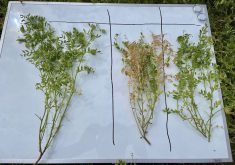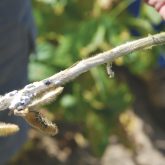Comparing resistance in fungicides to herbicides is like listening for a whisper above the noise of a pressure washer, or you could say the threat of disease resistance in major crops is advancing at a creep, not a run, as it is in weeds.
Increasingly, though, that’s a challenge facing agronomists, advisors and those in the chemical sector. They can talk about their concerns about fungicide resistance, and they can warn that it’s a matter of “when” not “if”, yet they also need to keep things in proper perspective. Calling attention too soon makes one an alarmist; waiting too long could result in greater resistance in disease pathogens.
Concerns regarding fungicide resistance are justified, with recent developments to different modes of action in North America in cereals, soybeans and sugar beets, as well as horticultural crops. The level of those incidents is greater in the U.S. than in Canada, but as with insect and weed species, what happens south of the border seldom remains there. There are also precautionary discussions (with supporting research) on increased fungicide use and potential cumulative effects on pollinators.
Read Also

Could crop sharing be a viable option for your farm?
Crop sharing could be a good option for young and beginning farmers.
Those who work within the crop protection sector are often the most vocal when it comes to expressing caution about the use of fungicides, the potential for resistance, and related issues. But they’re quick to acknowledge the key factors that differentiate fungicide use from herbicides or insecticides.
For instance, it’s easy to suggest fungicide resistance might mirror similar developments with herbicides but the two are significantly different. Weeds are an annual issue yet most biotypes are managed with an application of a herbicide or a tank mix, since there’s one generation of weeds per year.
By comparison, disease pathogens can reproduce new spores within two weeks under ideal conditions, meaning there will be multiple generations in a single growing season.
Herbicides are also used on a larger percentage of acres across North America compared to fungicides.
“When we look across row crops, virtually every acre is treated with a herbicide, so that’s a different extent of selection pressure that’s applied,” says Dr. Randy Myers, agronomic solutions manager with Bayer (U.S.) For years, growers were content with glyphosate, resulting in a break in the research pipeline. “The use of glyphosate hasn’t declined but the need for additional chemistries continues to increase, with a re-emphasis on herbicides.”
Slow to develop, quick to spread
Late in 2004, Asian soybean rust spores arrived in the U.S. on the winds of Hurricane Ivan, changing the demand for fungicides amid concerns about treating 80 million acres. In the end, the disease was confined to the southeastern states with 20 million acres actually treated. Since then, frogeye leaf spot has been confirmed as resistant to strobilurins in most areas of the U.S. where soybeans are grown, including recent finds in South Dakota.
The biggest surprise with resistance to strobilurin chemistries is the speed of its development, first determined by Dr. Carl Bradley from the University of Illinois (now with the University of Kentucky). Myers asked Bradley how many years of strobilurin use would have caused the resistance.
“I was expecting something like eight or nine years, something consistent with herbicides,” says Myers. “Bradley’s answer was two. That shocked me but it’s because we have so many generations in one year that the population can shift more dramatically than we’d anticipate.”

That such a significant shift occurred with frogeye leaf spot shouldn’t have been as big a surprise, adds Myers, since Cercospora is one of the most genetically diverse genera of fungi. Several strains are resistant to the strobilurin fungicides, including Cercospora leaf spot in sugar beets and Cercospora in peanuts, as well as in soybeans. The concern now is to limit its spread in other genera.
Another variation in herbicide resistance is the hit-and-miss frequency of selection pressure for weed seeds, which can be plowed down into a seed bank. It can take several years for seeds that might be resistant to produce a plant that sets seed and spreads its resistance. With disease pathogens, there isn’t the same degree of longevity.
Regardless of the variations in selection pressures or number of generations, Cornie Thiessen agrees that fungicide resistance needs to be acknowledged as a potential problem.
“We’ve seen the resistance challenges with herbicides and insecticides, and we know without good stewardship diseases can develop resistance to fungicides,” says Thiessen, Canadian general manager of Adama. “We also need to recognize that certain actives are being restricted or removed by regulators and this can increase selection pressure by the remaining actives.”
Thiessen agrees with Myers’s comment about Group 11 (strobilurin) chemistries and their susceptibility to resistance. For that reason, Adama will not launch a strobilurin fungicide in row crops without mixing in another mode of action. The company’s latest launch — Soratel — is registered for corn, wheat, barley, soybeans and other crops. Thiessen notes there’s still a good range of modes of action available and some diversity across actives within the same mode of action. With good stewardship practices, the industry can avoid the issues experienced with glyphosate.
Traditional plant breeding methods continue to provide incremental gains in disease resistance, and in Western Canada the cropping diversity and climate conditions have seen faster growth in fungicides in the past 10 years. But Thiessen notes the market size remains highly variable depending on environmental conditions.
“When you look at specific diseases, the range of active ingredients can narrow considerably,” says Thiessen. “It’s also true that many fungicides today rely on only three modes of action — Group 3, 7 and 11. It’s important to continue to evaluate actives containing additional modes.”
To rotate or combine
The thought process surrounding mixing of chemistries — versus rotating them — has been supported by a recent University of Illinois study which found tank mixing herbicides is 86 times more effective than rotating. Rothamsted Research in Hertfordshire, England, searched academic literature and found a similar correlation.
Thiessen suggests there are different degrees in the discussion. Rotating herbicides is better than continuous use of the same active ingredient, but rotation is less effective than mixing multiple modes of action. He believes the logic transfers to diseases and to fungicide use, as well.
“Additionally, we see disease management in a holistic way that includes managing alternate hosts with a complete herbicide program in post-harvest and pre-seed burn-downs,” he adds, citing diversity as an attribute. “We really see diversity as the underlying principle to effective stewardship: diversity of crops across years, diversity of genetics within a crop, diversity of agronomic practices and diversity of crop protection active ingredients.”
For many, “diversity” translates nicely into integrated pest management (IPM) strategies, a move that Chad Anderson supports. He echoes many of Myers’s and Thiessen’s perspectives, specifically noting the value of fungicides in producing higher-yielding crops.
“A lot of third-party research would suggest that on average, the response to fungicides is more of a break-even proposition,” says Anderson, a certified crop advisor (CCA) from Brigden, Ont. “But you have to consider the quality benefits, whether you’re lowering DON in corn and wheat or maybe producing a better-quality soybean seed for the food-grade market.”
Caution ahead
The industry must also learn both from the current spate of herbicide resistance as well as from the neonicotinoid issue of 2012-13. Excess dependence on any product can have negative impacts. Anderson points out a lot of continuous soybean crops in Lambton County get sprayed with fungicides. The better option would be to rotate.
The crop genetics are also improving, which can help growers avoid revenge spraying at the first sight of a lesion. Scouting a field and finding signs of infection can be frustrating, but with today’s genetics and disease tolerances in crops, a disease may not progress to the point where applying a fungicide provides an economic response.
“That said, for the most part today, we’re using multiple modes in products and that’s a great way to defend against resistance,” says Anderson. “There’s also a lot of work on the genetic front to understand which varieties or hybrids have the better tolerances for fungal disease, which again adds to protecting against disease development.”
The other lesson for fungicide use is off-target movement. With the neonic issue nearly 10 years ago, off-target movement of the products became a key deterrent. Anderson insists the industry must view fungicide applications with the same scrutiny.
“Too often, we apply fungicides in windy conditions when we wouldn’t apply a herbicide, because we believe there will be no damage from drift,” he states.
The increase of tar spot in corn this year will also change the conversation about fungicides. Tar spot has the potential to cause significant yield reductions and growers need in-crop fungicides as a management approach to battle this disease.
It means that if the fungicides now in use lose efficacy from resistance development, or if agriculture loses access due to public pressure, farmers will be in a bad way.
“Like all pesticide products, the best way forward is an integrated pest-management approach where we assess the risk for fungal disease and use fungicides wisely,” says Anderson. “Making good science-based decisions and applying in a stewardly manner will allow farmers access to fungicides that work to control disease for a long time.”
















